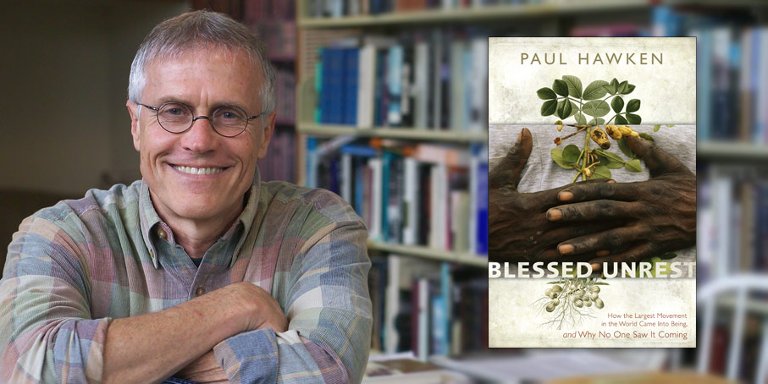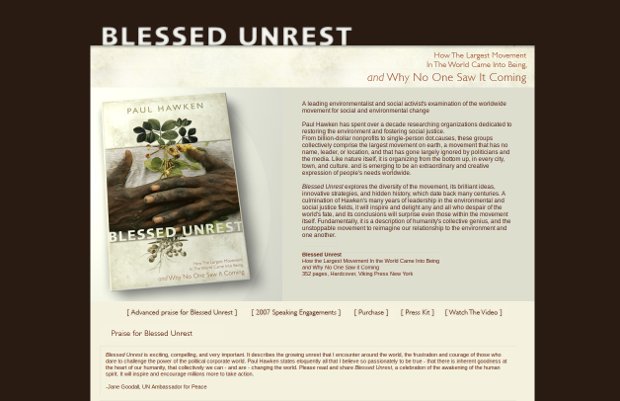 Paul Hawken has spent more than a decade researching organizations dedicated to restoring the environment and fostering social justice. From billion-dollar nonprofits to single-person dot.causes, these groups collectively comprise the largest movement on earth, a movement that has no name, leader, or location and that has gone largely ignored by politicians and the media. His book Blessed Unrest explores the diversity of the movement, its brilliant ideas, innovative strategies, and centuries of hidden history. A culmination of Hawken’s many years of leadership in the environmental and social justice fields, it will inspire all who despair of the world’s fate, and its conclusions will surprise even those within the movement itself. Blessed Unrest is indeed about a movement that no one has noticed, not even the people involved. “The movement,” as Paul Hawken calls it, is made up of an unknowable number of citizens and mostly ragtag organizations that come and go. But when you do see it, you understand it to include NGOs, nonprofit agencies and a seemingly disparate range of people who might describe themselves as environmental activists, as well as people who might not describe themselves as anything at all but are protesting labor injustices, monitoring estuaries, supporting local farming or defending native people from being robbed of the last forests. There are a few billionaires, working hard to give their wealth away, and there are even some Christian evangelicals, who have decided the earth is not theirs to trash, but the movement is mostly about shared beliefs, even if those beliefs are unproclaimed. Still confused? Skip to the 100-plus-page appendix, a list of movement-oriented concerns from child labor to “green banking” to climate change reflecting years of post-lecture business-card collecting on the author’s part. Hawken, the ecologically conscious founder of the gardening chain Smith & Hawken as well as a number of other enterprises involving things like sustainable agriculture and energy-saving technologies, makes the movement’s disparateness seem not so disparate — in its critique of markets, for example. “If there is a pervasive criticism of global capitalism that is shared by all actors in the movement, it is this observation: goods seem to have become more important, and are treated better, than people. What would a world look like if that emphasis were reversed?” The movement, most importantly, is very lowercase, its sensitivity being its great strength and, naturally, its tactical weakness.
Paul Hawken has spent more than a decade researching organizations dedicated to restoring the environment and fostering social justice. From billion-dollar nonprofits to single-person dot.causes, these groups collectively comprise the largest movement on earth, a movement that has no name, leader, or location and that has gone largely ignored by politicians and the media. His book Blessed Unrest explores the diversity of the movement, its brilliant ideas, innovative strategies, and centuries of hidden history. A culmination of Hawken’s many years of leadership in the environmental and social justice fields, it will inspire all who despair of the world’s fate, and its conclusions will surprise even those within the movement itself. Blessed Unrest is indeed about a movement that no one has noticed, not even the people involved. “The movement,” as Paul Hawken calls it, is made up of an unknowable number of citizens and mostly ragtag organizations that come and go. But when you do see it, you understand it to include NGOs, nonprofit agencies and a seemingly disparate range of people who might describe themselves as environmental activists, as well as people who might not describe themselves as anything at all but are protesting labor injustices, monitoring estuaries, supporting local farming or defending native people from being robbed of the last forests. There are a few billionaires, working hard to give their wealth away, and there are even some Christian evangelicals, who have decided the earth is not theirs to trash, but the movement is mostly about shared beliefs, even if those beliefs are unproclaimed. Still confused? Skip to the 100-plus-page appendix, a list of movement-oriented concerns from child labor to “green banking” to climate change reflecting years of post-lecture business-card collecting on the author’s part. Hawken, the ecologically conscious founder of the gardening chain Smith & Hawken as well as a number of other enterprises involving things like sustainable agriculture and energy-saving technologies, makes the movement’s disparateness seem not so disparate — in its critique of markets, for example. “If there is a pervasive criticism of global capitalism that is shared by all actors in the movement, it is this observation: goods seem to have become more important, and are treated better, than people. What would a world look like if that emphasis were reversed?” The movement, most importantly, is very lowercase, its sensitivity being its great strength and, naturally, its tactical weakness.  Website: http://www.blessedunrest.com/
Website: http://www.blessedunrest.com/
Blessed Unrest
![]()
STAY IN TOUCH
SUBSCRIBE TO OUR NEWSLETTER
AND RECEIVE OUR LATEST STORIES
OLBIOS NETWORK FOR ACTION










